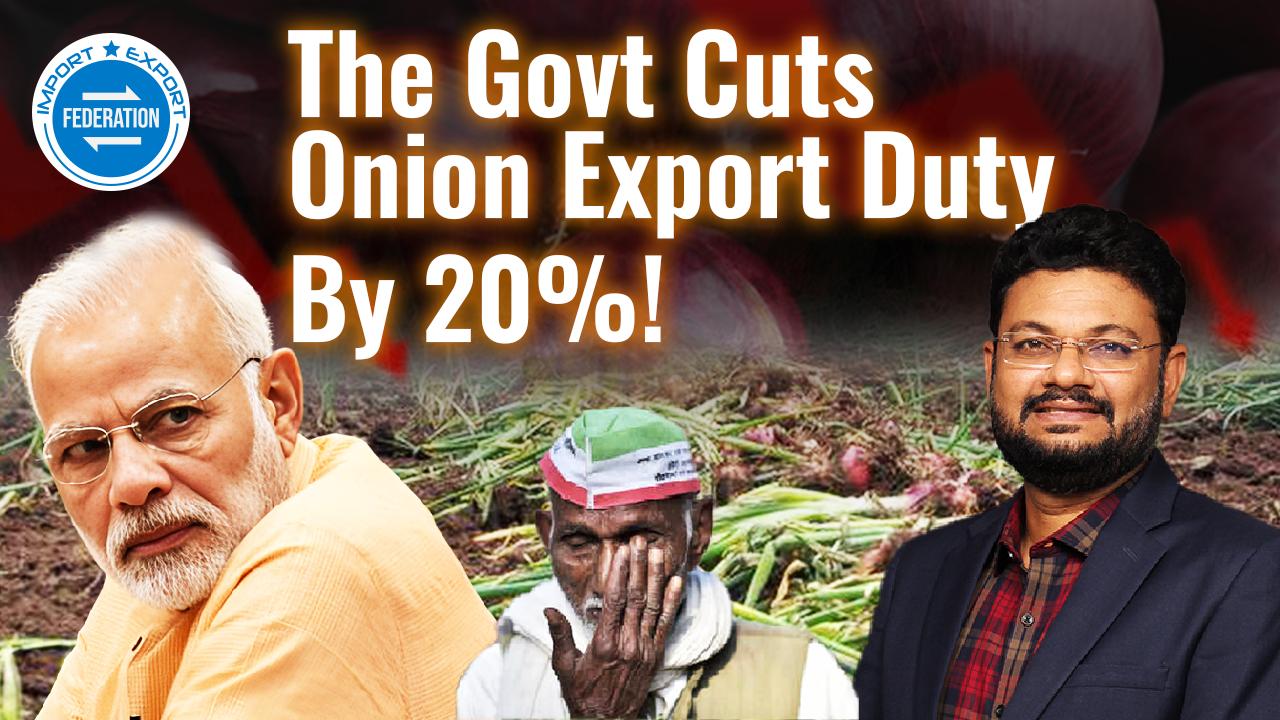Since Govt of India as cut Onion Export Duty by 20% effective from 1st April 2025, and if you are an exporter, trader, supplier or farmer and don’t have the capital, experience, or risk appetite to enter a price-sensitive market immediately, here’s what you should do instead of rushing into exports of Onion:
If you are looking for licenses or documentation help from Import Export Federation, please click here and connect with our team.
1. Become a Sourcing Specialist Before Exporting during and after Onion Export Duty changes
- Instead of immediately exporting, connect with Indian onion suppliers and growers.
- Build a network of reliable farmers and traders who can supply at competitive prices.
- Many big buyers in Gulf & Asia need trusted sourcing partners instead of direct exporters.
2. Offer Trade Support Services
If you’re not exporting yet, start by offering these services to established exporters & buyers:
- Sourcing & Procurement – Find, verify, and inspect suppliers for buyers.
- Logistics & Shipping Coordination – Help with container bookings, freight negotiations, and custom clearance.
- Market Research & Pricing Analysis – Track onion prices across multiple ports & markets (Al Aweer, Chittagong, Jeddah, etc.).
- Quality Inspection & Grading – Act as a quality assurance partner for buyers who don’t trust new suppliers.
- Documentation Assistance – Help in export documentation, certification, and compliance to smoothen trade.
💡 Why This Works when Onion Export Duty changes are made by Govt?
- No financial risk but you still get hands-on trade experience.
- You build relationships with importers, commission agents, and logistics partners.
- You become a trusted player in the supply chain—later making it easier to transition into direct exporting.
3. Secure Smaller, Controlled Deals First
- Instead of trying to export large volumes to Al Aweer or Bangladesh (where price drops are brutal), start with niche, premium markets like:
- Maldives (resorts & high-end buyers)
- Europe (buyers who prefer better packaging & certification)
- High-end food processors & restaurants (who need a steady quality supply)
- Export small, trial shipments first → learn how pricing, logistics, and payment terms work.
4. Stay Away from Volume Wars & Focus on Value Addition
- Usually exporters and suppliers wake up when Govt. changes Onion Export Duty however, it is advisable not to compete with big exporters on volume—you will lose. Instead, differentiate by offering:
- Premium sorted & graded onions (higher margin than bulk shipments).
- Branded packaging with QR codes for traceability.
- Onions with extended shelf life using better storage techniques.
💡 Example:
Instead of selling raw onions at a low price, supply pre-graded, pre-packed onions to specialty buyers in Singapore or Hong Kong supermarkets.
5. Build Direct Buyer Relationships, Skip Commission Agents
- Instead of relying on Al Aweer’s commission system, where prices fluctuate daily,
focus on direct contracts with supermarkets, wholesalers & food processors in:- UAE & Oman (Retail supply chains like Carrefour, Lulu, Nesto)
- Russia & Eastern Europe (Premium onion demand, less competition)
- Singapore & Malaysia (High-end food service industry)
- Use LinkedIn, B2B marketplaces (like Alibaba, TradeIndia, Export Genius) to find direct buyers.
Expanding your export business Further …
Expanding your export business further to high-margin markets requires strategic targeting of countries and buyers who value the quality of Indian red onions. Here’s a tailored approach:
1. Identify High-Potential Markets
The global import trends data suggests that focusing on following will be more beneficial:
- United States: One of the biggest importers worldwide, the U.S. imported onions valued at $787 million in 2023. The Observatory of Economic Complexity
- United Kingdom: As a significant European market, the UK presents substantial demand for quality onions. cbi.eu
- Germany: Another major European importer with a consistent need for fresh produce.
- Netherlands: Serves as a hub for distribution across Europe, increasing its import significance.
- Malaysia: Malaysia remains a key player in the onion import market with $440 million imports. The Observatory of Economic Complexity
2. Research and Connect with Importers
To establish direct relationships and avoid intermediaries, consider the following strategies:
- United States: Platforms like Volza provide directories of active buyers. For instance, GOURMET USA has been identified as a significant importer of Indian red onions. Volza Data Source
- United Kingdom, Germany, Netherlands: Connect with importers and distributors who are specialized in fresh produce by attending international good trade fairs and also utilize the trade databases.
- Malaysia: Local chambers of commerce and trade associations engagement is crucial to identify potential buyers and understand market requirements.
3. Understand Market Entry Requirements
Each country has specific standards and regulations:
- European Union: Compliance with EU quality standards, certifications, and phytosanitary requirements is crucial. Detailed guidelines are available through resources like the Centre for the Promotion of Imports (CBI). cbi.eu
Get detailed guidelines are available through resources like the Centre for the Promotion of Imports (CBI ) for compliance with EU quality standards, certifications, and phytosanitary requirements. cbi.eu - United States: Ensure adherence to USDA regulations and consider obtaining certifications that highlight the quality and safety of your produce.
4. Differentiate Your Product
In competitive markets, differentiation is key:
- Quality Assurance: Implement stringent quality control measures to ensure consistency.
- Branding & Positioning: Developing a strong brand identity that resonates with health-conscious consumers many do not consider in the rush of making profits, but this is a critical step.
5. Leverage Trade Platforms
Utilize B2B platforms and trade directories to showcase your products:
- Volza: Provides insights into profitable markets and potential buyers. Volza
- Trade Fairs: Participate in international trade fairs to network and establish direct contacts.
6. Monitor Market Trends
Stay informed about global market dynamics:
- Import Patterns: Regularly review import statistics to identify emerging markets.
- Competitor Analysis: Competitors will always do something different to gain the advantage! So , understanding the strategies of other exporters to identify opportunities and threats.
By focusing on these strategies, you can position your business to effectively penetrate high-margin markets and establish sustainable relationships with premium buyers.
Conclusion for Exporters
- New exporters should NOT rush into high-competition markets (UAE, Bangladesh, Sri Lanka).
- Start by offering services like sourcing, quality inspection, and logistics support.
- Secure small trial shipments & focus on premium, stable-price markets.
- Long-term success comes from direct buyer relationships & market intelligence—not quick trades.
How farmer can deal with Onion Export Duty changes situations
Here is how Indian Farmers can also ensure maximum benefit out of such movements that are happening in the market.
To help Indian farmers unite under an FPC (Farmer Producer Company) and achieve better pricing stability in onion exports, here’s a 10-point expert strategy considering India’s socio-economic reality:
1. Form & Strengthen an FPC with Committed Farmers
- Ensure like-minded farmers join the FPC who are willing to cooperate and follow a common business model.
- Have a minimum land holding agreement (e.g., 100+ acres collectively) to ensure steady supply for exports.
2. Understand the Economics of Export-Oriented Farming
- Onion farming for export must be planned cyclically, not seasonally.
- If one farmer grows and sells once a year, he loses leverage. FPC should plan for continuous supply with different members harvesting at different times.
3. Storage & Post-Harvest Infrastructure is Key
- A cold storage facility within the FPC ensures onions can be stored when prices fall, preventing distress sales.
- Invest in sorting, grading, and packaging units to increase onion value instead of selling bulk at farmgate prices.
4. Direct Tie-Ups with Export Markets Instead of Middlemen
- Avoid commission agents in UAE, Bangladesh, and Sri Lanka, who manipulate prices.
- Register the FPC on international B2B platforms like Volza, TradeIndia, AgriBazaar, and Global GAP-certified buyer networks.
- Attend Gulfood, SIAL, and other international trade fairs to find long-term buyers.
5. Bulk Contract Farming with Exporters & Processors
- Instead of waiting for random export orders, negotiate fixed-price contracts before the season starts.
- Tie up with dehydration factories & processing plants that buy onions regularly for powders & processed food.
6. Price Hedging & Govt Support Utilization
- Use market intelligence platforms to track global onion price trends and time sales better.
- Farmers should demand MSP (Minimum Support Price) guarantees from the state government to ensure buffer pricing.
- Utilize subsidies & funds under NABARD, APEDA, and SFAC schemes to strengthen FPC capital.
7. Invest in Branding & Value Addition
- Instead of selling just “red onions,” position the product as a premium variety with clear quality standards.
- Create an FPC brand with a logo, GI tagging, and a unique name (e.g., Maharashtra Prime Onions).
- Buyers trust branded FPCs over individual farmers due to consistent supply & quality control.
8. Negotiate Collective Input Purchases for Cost Reduction
- Buy fertilizers, seeds, and pesticides in bulk through the FPC to lower input costs by 10-15%.
- Collaborate with agricultural research institutions for better-yielding varieties.
9. Set Up an Internal FPC Price Regulation System
- Avoid undercutting each other in pricing—create a minimum selling price for all members.
- Implement a revenue-sharing model where FPC sells in bulk and distributes profits fairly.
10. Train Farmers on Export Compliance & Certifications
- Get Global GAP, APEDA, and HACCP certifications to access premium buyers in Europe, the Middle East, and Southeast Asia.
- Provide basic training on quality, logistics, and export documentation to ensure smooth trading & avoid losses.
Conclusion: Maximum Profits through Collaboration, Not Competition
- An individual farmer cannot succeed alone in exports—FPC ensures better bargaining power & stable pricing.
- Eliminate middlemen, use market intelligence, and focus on branding & contract farming for sustainable profits.
- Leverage Govt subsidies, modern storage, and bulk purchasing to reduce costs & improve margins.
Would you like a detailed roadmap for FPC formation & export execution? 🚜📈
Resources :
https://oec.world/en/profile/hs/onions
https://www.cbi.eu/market-information/fresh-fruit-vegetables/onions/market-potential
https://www.linkedin.com/in/tony-zarka-1770173b
https://www.volza.com/p/indian-red-onions/buyers/buyers-in-united-states
https://www.volza.com/company-profile/gourmet-usa-3448042/contacts
https://www.cbi.eu/market-information/fresh-fruit-vegetables/onions/market-entry




